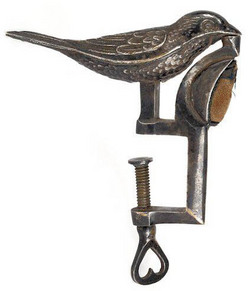 Few people sew these days and the majority of those who do use a vast area of expensive equipment and gadgetry, but “sewing notions,” as they’re often called, are nothing new. Take, for instance, the sewing bird. In the days before things like quilting hoops and dressmaker dummies (or at least affordable ones), a woman stitching would use a sewing bird to clamp her work to the edge of a table top, keeping a steady tension as she worked on a seam. A sewing bird is simply a clamp, made of everything from brass to wood, embossed tin to bone, cast iron to wrought iron, typically with a figural top in the form of a bird. Sewing clamps dating back to the 16th and 17th centuries have been discovered, but their heyday was the 19th century, when sewing birds in particular were popular. Initially they were a screw-type clamp, but later models sometimes employed springs. They occasionally appear in other forms – frogs, dolphins – but perhaps birds were the most common because when in use it appeared as though the bird was “perched” on the table. And, since the sewing bird was just sitting right there, the form was soon embellished, often appearing with a small pincushion.
Few people sew these days and the majority of those who do use a vast area of expensive equipment and gadgetry, but “sewing notions,” as they’re often called, are nothing new. Take, for instance, the sewing bird. In the days before things like quilting hoops and dressmaker dummies (or at least affordable ones), a woman stitching would use a sewing bird to clamp her work to the edge of a table top, keeping a steady tension as she worked on a seam. A sewing bird is simply a clamp, made of everything from brass to wood, embossed tin to bone, cast iron to wrought iron, typically with a figural top in the form of a bird. Sewing clamps dating back to the 16th and 17th centuries have been discovered, but their heyday was the 19th century, when sewing birds in particular were popular. Initially they were a screw-type clamp, but later models sometimes employed springs. They occasionally appear in other forms – frogs, dolphins – but perhaps birds were the most common because when in use it appeared as though the bird was “perched” on the table. And, since the sewing bird was just sitting right there, the form was soon embellished, often appearing with a small pincushion.
As sewing birds go at auction, value seems to be “clamped” to a couple factors, aside from the usual caveats about age and condition (the spring models in particular are often damaged): materials and form. Bird forms make up the vast majority of those that appear at auction, so rarer forms can command bigger prices and standard mass-manufactured versions from cast iron or brass have far less value than those made from rare more “individualized” handcraft materials such as wrought iron, wood and bone.



